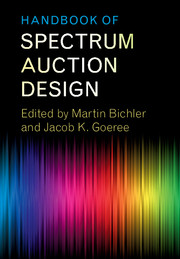Book contents
- Frontmatter
- Contents
- List of Contributors
- Preface
- List of Papers
- Part I The Simultaneous Multiple-Round Auction
- Part II The Combinatorial Clock Auction Designs
- Part III Alternative Auction Designs
- Part IV Experimental Comparisons of Auction Designs
- 25 Experiments Testing Multiobject Allocation Mechanisms
- 26 Laboratory Experimental Testbeds: Application to the PCS Auction
- 27 An Experimental Test of Flexible Combinatorial Spectrum Auction Formats
- 28 On the Impact of Package Selection in Combinatorial Auctions: An Experimental Study in the Context of Spectrum Auction Design
- 29 Do Core-Selecting Combinatorial Clock Auctions Lead to High Efficiency? An Experimental Analysis of Spectrum Auction Designs
- 30 Spectrum Auction Design: Simple Auctions For Complex Sales
- Part V The Bidders’ Perspective
- Part VI Secondary Markets and Exchanges
- Outlook
- References
27 - An Experimental Test of Flexible Combinatorial Spectrum Auction Formats
from Part IV - Experimental Comparisons of Auction Designs
Published online by Cambridge University Press: 26 October 2017
- Frontmatter
- Contents
- List of Contributors
- Preface
- List of Papers
- Part I The Simultaneous Multiple-Round Auction
- Part II The Combinatorial Clock Auction Designs
- Part III Alternative Auction Designs
- Part IV Experimental Comparisons of Auction Designs
- 25 Experiments Testing Multiobject Allocation Mechanisms
- 26 Laboratory Experimental Testbeds: Application to the PCS Auction
- 27 An Experimental Test of Flexible Combinatorial Spectrum Auction Formats
- 28 On the Impact of Package Selection in Combinatorial Auctions: An Experimental Study in the Context of Spectrum Auction Design
- 29 Do Core-Selecting Combinatorial Clock Auctions Lead to High Efficiency? An Experimental Analysis of Spectrum Auction Designs
- 30 Spectrum Auction Design: Simple Auctions For Complex Sales
- Part V The Bidders’ Perspective
- Part VI Secondary Markets and Exchanges
- Outlook
- References
Summary
Simultaneous auctions for multiple items are often used when the values of the items are interrelated. An example of such a situation is the sale of spectrum rights by the Federal Communications Commission (FCC). If a telecommunications company is already operating in a certain area, the cost of operating in adjacent areas tends to be lower. In addition, consumers may value larger networks that reduce the cost and inconvenience of “roaming.” As a consequence, the value of a collection of spectrum licenses for adjacent areas can be higher than the sum of the values for separate licenses. Value complementarities arise naturally in many other contexts, e.g. aircraft takeoff and landing slots, pollution emissions allowances for consecutive years, and coordinated advertising time slots. This paper reports a series of laboratory experiments to evaluate alternative methods of running multi-unit auctions, in both high and low-complementarities environments.
Various auction formats have been suggested for selling multiple items with interrelated values. The most widely discussed format is the simultaneous multiple round (SMR) auction, first used by the FCC in 1994. In the SMR auction, bidders are only allowed to bid on single licenses in a series of “rounds,” and the auction stops when no new bids are submitted on any license. To win a valuable package of licenses in this type of auction, bidders with value complementarities may have to bid more for some licenses than they are worth individually, which may result in losses when only a subset is won. Avoidance of this “exposure problem” may lead to conservative bidding, lower revenue, and inefficient allocations.
The obvious solution to the exposure problem is to allow bidding for packages of items. In such combinatorial auctions, bidders can make sure they either win the entire package or nothing at all. As a result, bids can reflect value complementarities, which should raise efficiency and seller revenue. Combinatorial bidding, however, may introduce new problems. Consider a situation in which a large bidder submits a package bid for several licenses. If other bidders are interested in buying different subsets of licenses contained in the package, they might find it hard to coordinate their actions, even if the sum of their values is higher than the value of the package to the large bidder (the threshold problem). Thus, there is no clear presumption that package bidding will improve auction performance.
Information
- Type
- Chapter
- Information
- Handbook of Spectrum Auction Design , pp. 588 - 606Publisher: Cambridge University PressPrint publication year: 2017
